striped bass
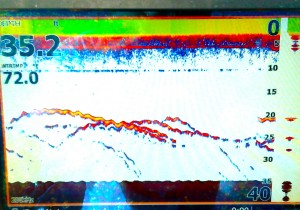 Suspended fish, I hate ‘em. Scattered fish suspending in deep water is one of the most difficult situations a light tackle angler will encounter on the Chesapeake Bay. In years past, I’ve refused to target suspended fish. I’d rather run fifteen additional miles looking for stripers feeding off the bottom than fool with the picky little snots. But, as Bob Dylan might say, The Times, They Are a Changin’. Bad water makes everything different. As predicted in my last entry, low oxygen levels have led to prolific algae blooms in the tributary rivers and in some areas of the main stem of the Bay. Conditions are worse around the western shore rivers since more people live there and there is more pollution.
Suspended fish, I hate ‘em. Scattered fish suspending in deep water is one of the most difficult situations a light tackle angler will encounter on the Chesapeake Bay. In years past, I’ve refused to target suspended fish. I’d rather run fifteen additional miles looking for stripers feeding off the bottom than fool with the picky little snots. But, as Bob Dylan might say, The Times, They Are a Changin’. Bad water makes everything different. As predicted in my last entry, low oxygen levels have led to prolific algae blooms in the tributary rivers and in some areas of the main stem of the Bay. Conditions are worse around the western shore rivers since more people live there and there is more pollution.
Pollution, especially nutrients like nitrates and phosphorus get into the Bay as a result of raw sewage dumping, storm-water runoff, and excessive fertilizer use. This makes the water very fertile, so small microscopic plants such as algae grow rapidly. The algae cells block sunlight, then die and sink to the bottom creating areas of low oxygen where fish can’t survive. Since dissolved oxygen levels were already at record lows this year, it didn’t take long for the blooming and decaying cycle to use up whatever oxygen was left. Read More!
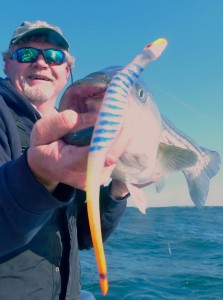 Along with sneaking in a couple of catch-and-release fishing trips, I’ve been reading all I can lately about why we catch fish with ease on some days, and why we cant buy a bite at other times. I can’t say I’ve solved that mystery, but I’ve included most of the knowledge I’ve gained in a PowerPoint slide show that I will present over the next couple of months to area fishing clubs. If you attended the Annapolis Saltwater Fishing Expo last weekend, you’ve already seen this show, but don’t be surprised if it morphs into a somewhat different format as I present it to different groups and organizations. I learn more every time I talk to fellow fishermen, pick up a book, read a magazine article, look at a website, and (especially) when I go fishing. Here’s a sneak preview of my Strike Triggers presentation:
Along with sneaking in a couple of catch-and-release fishing trips, I’ve been reading all I can lately about why we catch fish with ease on some days, and why we cant buy a bite at other times. I can’t say I’ve solved that mystery, but I’ve included most of the knowledge I’ve gained in a PowerPoint slide show that I will present over the next couple of months to area fishing clubs. If you attended the Annapolis Saltwater Fishing Expo last weekend, you’ve already seen this show, but don’t be surprised if it morphs into a somewhat different format as I present it to different groups and organizations. I learn more every time I talk to fellow fishermen, pick up a book, read a magazine article, look at a website, and (especially) when I go fishing. Here’s a sneak preview of my Strike Triggers presentation:
Have you noticed that some fishermen seem to steadily catch big fish and regularly have successful days even when others don’t? What are they doing differently? In my opinion, one trait of consistently productive fishermen is an appreciation for the concept of strike triggers. They may not always call it that, but you can pretty well bet that good fishermen are incorporating techniques in their lures and lure presentations that trick fish into biting even when they’re not particularly inclined to eat. It starts with a good understanding of the five reasons why striped bass attack a lure. Read More!
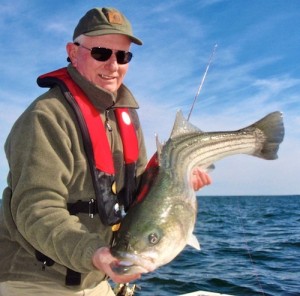 Last December, I caught up with my friend Gaylon Thompson at one of my light tackle seminars in Severna Park, Maryland. During the few minutes we had to talk, we wondered if we might be able to get in a fishing trip in early 2012. I was very excited when Rich Jenkins called me last week to say he and Gaylon were heading down to Virginia to fish in the ocean Monday, and I was invited. He also invited Jamie Clough. We’ve been hearing about the coastline bite for a while now from Wild Bill and other fishermen who follow the migration. Even though I’m turning up a few hard-to-catch but very big fish here in the Bay, we couldn’t resist giving it a go. Our first challenge was deciding whether to fish the Chesapeake Bay Bridge Tunnel, or the ocean. We called, emailed, and Facebooked everyone we could think of seeking advice. Some of our friends came though, especially “Hillbilly Boater” Jack, and a couple of Jamie’s buddies. I also got some good info from some of Tattoo Charlie’s buds on Facebook. Read More!
Last December, I caught up with my friend Gaylon Thompson at one of my light tackle seminars in Severna Park, Maryland. During the few minutes we had to talk, we wondered if we might be able to get in a fishing trip in early 2012. I was very excited when Rich Jenkins called me last week to say he and Gaylon were heading down to Virginia to fish in the ocean Monday, and I was invited. He also invited Jamie Clough. We’ve been hearing about the coastline bite for a while now from Wild Bill and other fishermen who follow the migration. Even though I’m turning up a few hard-to-catch but very big fish here in the Bay, we couldn’t resist giving it a go. Our first challenge was deciding whether to fish the Chesapeake Bay Bridge Tunnel, or the ocean. We called, emailed, and Facebooked everyone we could think of seeking advice. Some of our friends came though, especially “Hillbilly Boater” Jack, and a couple of Jamie’s buddies. I also got some good info from some of Tattoo Charlie’s buds on Facebook. Read More!
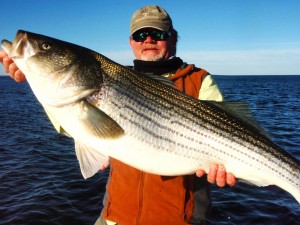 If the next 51 weeks of 2012 go as well as the first one, this promises to be a very good year for light tackle fishing on the Chesapeake Bay. I’ve fished four times and caught a Diamond Jim qualifying citation fish on each trip including three rockfish in the mid 40-inch range. I’m chalking it up to a little experience, some insider information, and a lot of luck. My son, “Big Fish Cory” has been visiting. Although he didn’t catch any trophies this time around, he still brought along his lucky horseshoe. Chesapeake striped bass fishermen have two basic winter options. One is to fish deep holes – either in the main stem of the Bay or up in the outside bends of the rivers – and the other is to work the warm water discharges. Since we’ve had a very mild winter so far, the warm water discharges have been inconsistent. I decided to split the difference and fish the last four days close to home off Kent Island.
If the next 51 weeks of 2012 go as well as the first one, this promises to be a very good year for light tackle fishing on the Chesapeake Bay. I’ve fished four times and caught a Diamond Jim qualifying citation fish on each trip including three rockfish in the mid 40-inch range. I’m chalking it up to a little experience, some insider information, and a lot of luck. My son, “Big Fish Cory” has been visiting. Although he didn’t catch any trophies this time around, he still brought along his lucky horseshoe. Chesapeake striped bass fishermen have two basic winter options. One is to fish deep holes – either in the main stem of the Bay or up in the outside bends of the rivers – and the other is to work the warm water discharges. Since we’ve had a very mild winter so far, the warm water discharges have been inconsistent. I decided to split the difference and fish the last four days close to home off Kent Island.
One of the best places I know of to jig up deep water rockfish is the Bay Bridge. Two- and three-year-old-stripers and white perch survive the cold winter by stacking up around the Bay Bridge rock piles. They’ll stay there until the spring freshet washes out their warm water comfort zones. Even though they are readily apparent on a fish finder, they aren’t always easy to catch. To coax a strike out of deep-water stripers you just have to aggravate them until they bite. You can jig for hours and not get a single strike, then, snap – the fish will turn on and you’re catching every cast. Read More!
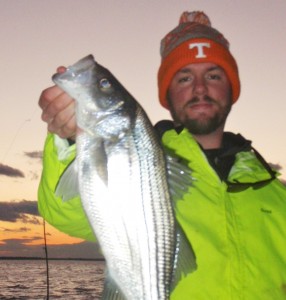 “One last drift,” I called up. My son was casting from the bow while I piloted the boat. It was getting dark and we had New Year’s Eve dinner plans in Annapolis, so we had to go. The better fish were holding in a warm water pyconocline; a spot no bigger than a pickup truck bed, 40-feet deep. I pointed the bow of my 27 Judge CC into the swift current and idled us into a position just downstream from the rocky corner. Daniel compensated for the strong flow and launched his hotrodded chartreuse BKD toward an imaginary spot 20-yards upstream from where he wanted his lure to touch the bottom. In water this swift, he’d be lucky if his jig bumped the rocks three times before it drifted downstream out of the strike zone. A successful cast either caught a fish, or brought up a clump of the brown bryzoan moss that covers the bottom. The only other option was to hang up. He brought his elbows together beneath the low-profile baitcaster and followed the arc of his line with his extra-fast rod tip as he anticipated the slight bump that would tell him his lure had touched the rocks.
“One last drift,” I called up. My son was casting from the bow while I piloted the boat. It was getting dark and we had New Year’s Eve dinner plans in Annapolis, so we had to go. The better fish were holding in a warm water pyconocline; a spot no bigger than a pickup truck bed, 40-feet deep. I pointed the bow of my 27 Judge CC into the swift current and idled us into a position just downstream from the rocky corner. Daniel compensated for the strong flow and launched his hotrodded chartreuse BKD toward an imaginary spot 20-yards upstream from where he wanted his lure to touch the bottom. In water this swift, he’d be lucky if his jig bumped the rocks three times before it drifted downstream out of the strike zone. A successful cast either caught a fish, or brought up a clump of the brown bryzoan moss that covers the bottom. The only other option was to hang up. He brought his elbows together beneath the low-profile baitcaster and followed the arc of his line with his extra-fast rod tip as he anticipated the slight bump that would tell him his lure had touched the rocks.
Bump. There it was. A quick snap of the wrist picked the jig back up before it had time to snag on the bottom. Again, he followed the line with his rod tip and waited for the bump as the lure fell. Watching the drop. Anticipating. Any moment now. Slam! Daniel set the hook and fought another 24-inch football-shaped striper to the side of the boat. That made seventeen in 90 minutes – a fun evening of catch & release fishing very close to home. Read More!
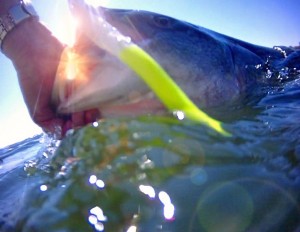 Thanks to everyone who made it to the re-creation of the Annapolis chapter of the Coastal Conservation Association (CCA) at the Boatyard Bar & Grill last night. There was a big turnout and we had a lot of fun. As I was driving to the meeting, I considered the concept of re-creating something as significant as a major chapter in a national conservation group. It’s obviously an important event, so I decided to collect my thoughts on the concept of re-creating. I looked up the word recreation and found that it simply means to create something anew. I suppose almost everyone who reads this website considers themselves recreational fishermen. The time we spend on and around the water helps us wind down and relax. So by fishing, we’re essentially restoring ourselves to a state-of-mind that makes it easier to face the daily challenges life throws our way. Read More!
Thanks to everyone who made it to the re-creation of the Annapolis chapter of the Coastal Conservation Association (CCA) at the Boatyard Bar & Grill last night. There was a big turnout and we had a lot of fun. As I was driving to the meeting, I considered the concept of re-creating something as significant as a major chapter in a national conservation group. It’s obviously an important event, so I decided to collect my thoughts on the concept of re-creating. I looked up the word recreation and found that it simply means to create something anew. I suppose almost everyone who reads this website considers themselves recreational fishermen. The time we spend on and around the water helps us wind down and relax. So by fishing, we’re essentially restoring ourselves to a state-of-mind that makes it easier to face the daily challenges life throws our way. Read More!


